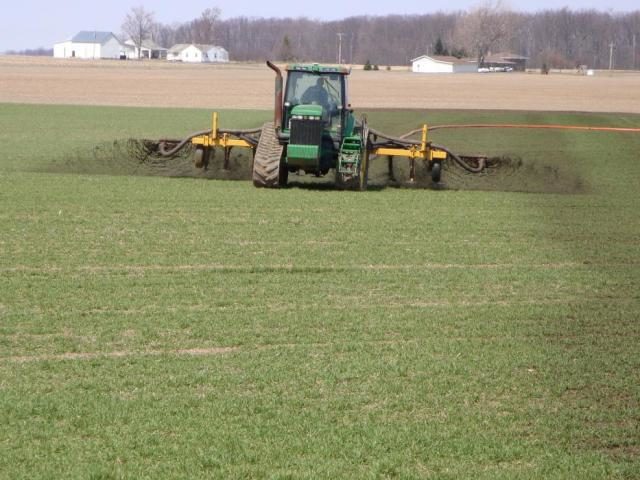By Glen Arnold, Field Specialist, Manure Nutrient Management
Research on applying liquid livestock manure as a spring topdress fertilizer to wheat has been ongoing in Ohio for several years. There is usually a window of time, typically around the last week of March or the first week of April, when fields are firm enough to support manure application equipment. The wheat fields have broken dormancy and are actively pulling nutrients from the soil.
The key to applying the correct amount of manure to fertilize wheat is to know the manure’s nitrogen (N) content. Most manure tests reveal total N, ammonia N and organic N amounts. The ammonia N portion is readily available for plant growth. The organic N portion takes considerably longer to mineralize and generally will not be available when wheat uptakes the majority of its N in the months of April and May.
Some manure tests also list a “first year availability” N amount. This number is basically the ammonia N portion of the manure plus about half the organic N portion. Again, for the purpose of fertilizing wheat, the organic portion of the N should not be considered available in time to impact yields.
Most deep-pit swine finishing manure will contain between 32 and 45 pounds of ammonia N per 1,000 gallons. Finishing buildings with bowl waters and other water conservation systems can result in N amounts towards the upper end of this range. Finishing buildings with fixed nipple waters and surface water occasionally entering the pit can result in N amounts towards the lower end of this range.
To capture the most nutrients from manure farmers should consider incorporation. Incorporation can result in less N loss and can especially reduce the loss of dissolved reactive phosphorus. Unfortunately, there are very few toolbars designed to incorporate manure into wheat.
Three years of on-farm wheat topdress results are summarized in Table 1. Each field trial was replicated four times. In each plot, the manure ammonia N application rate was similar to the N amount in the urea fertilizer; typically about 100 pounds per acre. The manure was applied using a 4,800-gallon tanker with a Peecon toolbar 13.5 feet in width. This toolbar cut the soil surface with a straight coulter and a boot applied the manure over the soil opening. Urea was applied using a standard fertilizer buggy.
| Year | Swine manure (surface applied) | Swine manure (Incorporated)* | Urea | Date of nutrient application |
| 2009 | 127.5 | 125.4 | 128.2 | April 7 |
| 2008 | 63.1 | 61.4 | 62.9 | April 3 |
| 2007 | 102.2 | 98.0 | 96.5 | March 28 |
In addition to the Peecon toolbar, OSU Extension as also conducted manure research on wheat using the both the Veenhuizen toolbar and Aerway toolbar. All toolbars cutting through the soil cause some disruption to the growing wheat but side-by-side yield comparisons with convention surface applied fertilizer have rarely shown any difference in yields.
Some Ohio commercial dragline operators are routinely applying livestock manure to wheat each spring. This practice is gaining acceptance as it’s faster and more efficient than manure application with a tanker. The risk of soil compaction is also reduced.
Dairy manure has been utilized with on-farm research plots when topdressing wheat. Dairy manure contains far less ammonia N per 1,000 gallons than swine finishing manure and does not consistently produce wheat yields similar to commercial fertilizer. Research on dairy manure as a topdress to wheat by adding 28% UAN to the dairy manure to increase its fertilizer value has produced wheat yields similar to commercial N.
When applying livestock manure to wheat it’s recommended to follow the NRCS #633 Waste Utilization Standard to minimize potential environmental impacts. These standards include a 35-foot-wide vegetative filter strip setback from ditches and streams. Applicators also need to look at the weather forecast to be certain there is not greater than a 50% chance of a half-inch of rain in the following 24 hours. Print this forecast out so you have proof in the event of a surprise downpour.
Additional on-farm manure topdress of wheat plot results can be obtained by clicking on the on-farm research link on the OSU Extension Agronomics Crops team website.






